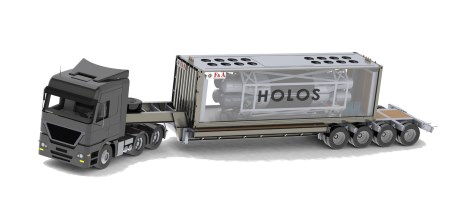DOE announces funding for innovative nuclear technology
05 June 2018
Ten projects have been selected to receive a total of up to USD24 million in funding under a new programme from the US Department of Energy's (DOE) Advanced Research Projects Agency-Energy (ARPA-E) initiative. The projects selected include a transportable gas-cooled reactor, and technology to support load-following, improve safety and reduce costs in advanced reactors.
 |
| HolosGen's integral reactor is designed to fit inside a standard shipping container, making it highly portable (Image: HolosGen) |
ARPA-E's Modelling-Enhanced Innovations Trailblazing Nuclear Energy Reinvigoration (MEITNER) programme was launched last October to leverage design, new manufacturing processes and technologies to lower costs and increase competitiveness of nuclear power. The funded projects will support advanced reactor designs to achieve lower construction costs and autonomous operations while improving safety. MEITNER teams will also have access to DOE modelling and simulation resources as they develop their concepts.
Describing nuclear energy as an essential component of the US energy mix, Energy Secretary Rick Perry yesterday said teaming up with the private sector to reduce costs and improve safety would keep the country "ahead of the curve" in advanced reactor design and technology.
"These next-generation ARPA‑E technologies help us maintain our competitive, technological edge globally, while improving the resilience of the grid and helping provide reliable, baseload electricity," he said.
Westinghouse Electric Company's project to develop a self-regulating solid core block using solid materials, instead of bulk liquid flow or moving parts, to inherently regulate the reaction rate in a nuclear reactor receives the single largest award of USD5 million.
Projects from North Carolina State University, to develop a "nearly autonomous" management and control system for advanced reactors, and Terrestrial Energy USA, Inc, to develop magnetically suspended canned rotor pumps for the integral molten salt reactor, receive over USD3 million each.
Yellowstone Energy of Knoxville, Tennessee receives USD2.6 million to develop a new reactor control technology to enhance passive safety and reduce costs for molten salt and other reactor designs, while Seattle, Washington-based Ultra Safe Nuclear Corporation receives USD2.35 million to develop advanced technologies for gas-cooled reactors to increase their power density, thus allowing them to be smaller.
HolosGen, based in Manassas Park, Virginia, receives USD2.3 million to develop a gas-cooled nuclear reactor with load following ability that can be packaged in a standard shipping container. By using a closed Brayton cycle engine with components connected directly to the reactor core, the team expects to simplify plant construction, leading to lower costs and shorter commissioning times. The team aims to demonstrate the viability of this concept using multi-physics modelling and simulation tools validated by testing a non-nuclear prototype.
The remainder of the funding goes to two projects from General Atomics - one to improve load-following in advanced nuclear plants, and another to develop new construction methods for concrete components - plus projects from the State University of New York at Buffalo, to integrate seismic protection systems into the development of advanced reactor buildings, and the University of Illinois at Urbana-Champaign, to develop a fuel processing system enabling load-following in molten salt reactors.
Researched and written
by World Nuclear News